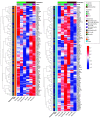Modulation of Neuroimmune and Epithelial Dysregulation in Patients With Moderate to Severe Prurigo Nodularis Treated With Nemolizumab
- PMID: 37556125
- PMCID: PMC10413221
- DOI: 10.1001/jamadermatol.2023.2609
Modulation of Neuroimmune and Epithelial Dysregulation in Patients With Moderate to Severe Prurigo Nodularis Treated With Nemolizumab
Abstract
Importance: Prurigo nodularis (PN) is a debilitating skin disease characterized by intense pruritus and hyperkeratotic skin nodules. Nemolizumab, a monoclonal antibody targeting interleukin 31 receptor α, is a promising novel therapy for the treatment of moderate to severe PN. The biological mechanisms by which nemolizumab promotes improvement of itch and skin lesions in PN are unknown.
Objective: To characterize changes in plasma protein biomarkers associated with clinical response to nemolizumab in patients with PN.
Design, setting, and participants: This multicenter cohort study included patients recruited from Austria, France, Germany, Poland, and the US from a phase 2 clinical trial. Adults diagnosed with moderate to severe PN with severe pruritus for at least 6 months were included in the original trial. Patients in the nemolizumab group were included in the present study if they achieved at least a 4-point decrease in the Peak Pruritus Numerical Rating Scale (PP-NRS) from baseline to week 12 during nemolizumab treatment. Placebo controls did not experience a 4-point decrease in PP-NRS. Mass spectrometry with tandem mass tags to enrich skin-specific protein detection was used to characterize changes in plasma protein expression in nemolizumab and placebo groups. Data were collected from November 2, 2017, to September 26, 2018, and analyzed from December 6, 2019, to April 8, 2022.
Intervention: As part of the clinical trial, patients were treated with 3 doses of nemolizumab or placebo at 0, 4, and 8 weeks.
Main outcomes and measures: Changes in plasma and epidermal protein expression in nemolizumab-treated patients compared with the placebo group at 0, 4, and 12 weeks.
Results: Among the 38 patients included in the analysis (22 women and 16 men; mean [SD] age, 55.8 [15.8] years), enrichment analysis of canonical pathways, biological functions, and upstream regulators showed downregulation of terms involving inflammation (IL-6, acute-phase response, signal transducer and activator of transcription 3, and interferon γ), neural processes (synaptogenesis signaling and neuritogenesis), tissue remodeling and fibrosis (transforming growth factor β1 and endothelin-1), and epidermal differentiation (epithelial mesenchymal transition) in the plasma of nemolizumab group.
Conclusions and relevance: In this cohort study, differences between nemolizumab and placebo groups included modulation of inflammatory signaling, neural development, and epithelial differentiation, suggesting a promising potential approach for clinical management of PN.
Conflict of interest statement
Figures




Comment in
-
Can Serum Biomarkers for Prurigo Nodularis Expose Pathophysiology or Just Treatment Response?JAMA Dermatol. 2023 Sep 1;159(9):915-917. doi: 10.1001/jamadermatol.2023.2608. JAMA Dermatol. 2023. PMID: 37556170 No abstract available.
References
Publication types
MeSH terms
Substances
LinkOut - more resources
Full Text Sources
Research Materials
Miscellaneous

